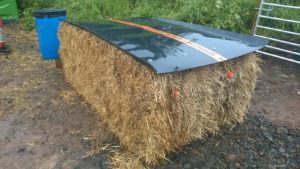Keeping Straw Stacks Dry
23 August 2017 Yorkshire pig producers, for whom 100% dry straw is critical, have encouraged the development of strong plastic sheets which can be firmly applied to a bale on the ground and then lifted up to “top off” the rick. The long sides of the sheets have upright sides, which meet up with the sheet on the adjacent bales. When in position they are slightly curved so rain is shed off at either end. This means that stacks have to have a 6 inch gap to allow the water to fall to the ground. (The shed rain could wet the ends of the bales as it falls to the ground. However this is minimised by the sheet overhanging the bale.)
Yorkshire pig producers, for whom 100% dry straw is critical, have encouraged the development of strong plastic sheets which can be firmly applied to a bale on the ground and then lifted up to “top off” the rick. The long sides of the sheets have upright sides, which meet up with the sheet on the adjacent bales. When in position they are slightly curved so rain is shed off at either end. This means that stacks have to have a 6 inch gap to allow the water to fall to the ground. (The shed rain could wet the ends of the bales as it falls to the ground. However this is minimised by the sheet overhanging the bale.)
The main advantage of the system is safety. The sheets can be quickly fixed while the bale is on the ground, avoiding anybody having to go on top of the stack. In addition, keeping all the bales dry puts less pressure on the stack, significantly reducing the chance of it collapsing.
In the winter the top bale can be taken down, the sheet quickly removed and stored ready for use again the following year.
One restriction is the stack must be built on a very free draining base or concreate to avoid forming strips of wet, soft ground, encouraging the stack and more importantly loaded tractors to tilt and bales to fall.
In very wet conditions some producers take off the top, sheeted bale, put it to one side, remove as many dry bales as they need and then replace the sheeted bale back on top of the bales left in the stack.
For more details contact sales@haycap.co.uk
Gavin Hill, gavin.hill@sac.co.uk
Sign up to the FAS newsletter
Receive updates on news, events and publications from Scotland’s Farm Advisory Service
